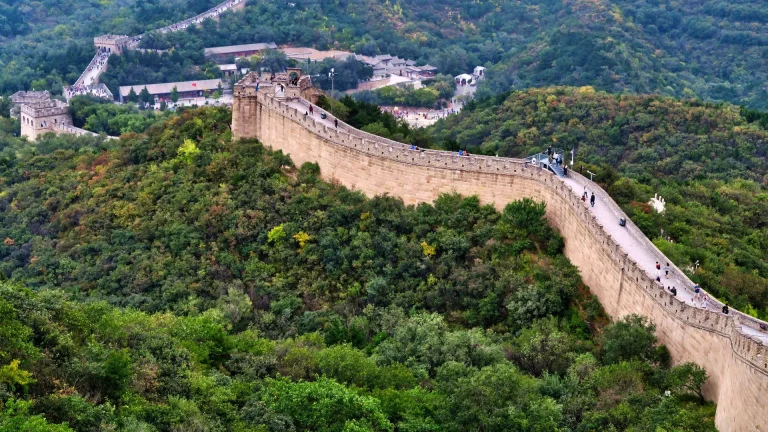The Great Wall of China is the world’s largest, widest, and oldest wall. This wall is so ancient that the outside world had once forgotten about it. Its mention was confined to the pages of encyclopedias or hefty volumes of the wonders of the world, which few people bother to flip through. Suddenly, at the beginning of 1950, this news appeared in the newspapers: ‘The Communist Chinese government has decided to demolish the world’s oldest wall so that its stones can be used for the city’s repairs and its materials can be used to erect new buildings.’ This news once again revived the memory of this forgotten wall in people’s minds and sparked a search in the hearts of new individuals to discover its wonders. Though the walls crumble every day, and nobody even asks about it, for destruction is the nature of this world, and defeat and upheaval are its norms.
Difference in Wall, wall
In fact, there is a difference within walls. Some walls are covered with advertisements from around the world in a highly untidy manner. Various posters are displayed as well. There are walls that nobody bothers to look at. They are the walls adorned with layers of dust from top to bottom. They present a highly unpleasant sight in front of every passerby. And there are also walls where a dedicated staff is constantly engaged in the task of sweeping and cleaning for maintenance purposes.
There are buildings in the world that have crumbled and transformed into ruins. However, due to their historical significance, they have a dedicated department and staff working day and night to preserve them. The Great Wall of China is also one of those ancient treasures.
It is considered one of the wonders of the world for several reasons. Firstly, the Great Wall of China is the oldest wall within the world. Furthermore, its length surpasses that of any other wall, and its width is also greater than all other walls. Additionally, the Great Wall of China sets an example of endurance and maturity. Countless individuals contributed to its construction, working tirelessly day and night, completing it. This wall has halted many calamities and embraced numerous historical events within its embrace.
Location
The Great Wall of China was constructed on the border between the Mongols and the Khitans. However, today there is neither a Khitan presence nor any region named after the Tartars. According to the modern geographical boundaries of the world, the current shared territory of China extends approximately fifteen hundred miles north in the north of China. One end of it was in the western-central deserts of Asia, while the other end reached the coast in the east.
Today, everyone is familiar with the name Beijing. This city is the capital and central city of modern China. The Great Wall of China is 36 miles northwest of Beijing. The other end of the wall terminates at the Sungari River. It is the famous place in the plains of China situated between these two important rivers, known as the “Yellow River” and the “Hun River.”
Beijing was occupied by British and American allied forces on August 14, 1900. The Communist Chinese government gained control of the city in 1949. Beijing can be described as a city of historical buildings, royal palaces, towers, and lofty minarets.
Construction year of the Great Wall of China
The construction of this magnificent white-colored wall took place during the reign of Emperor Chih Shih huang ti of China. According to the author of ‘Seven Wonders of the World,’ Deena Nath, its construction was dated to 240 BC. The Great Encyclopedia of Universal Knowledge states its construction year as 215 BC. However, Britannica Encyclopedia contradicts both and mentions the construction year as either 228 or 214 BC. The consensus is that a section of the Great Wall of China was built in 228 BC, but its completion took place in 214 BC. In summary, it is widely agreed that the construction of the Great Wall of China occurred around 200-250 years before the birth of Jesus Christ. This means that Emperor Chih Shih huang ti discovered a period more than a hundred years before the birth of Jesus, and it is evident that after conquering all the countries in the region, he initiated the construction and completion of the wall.
Purpose of construction
The tradition of building walls and fortifications in buildings is as ancient as human civilization. The construction of city walls and castle fortifications has been an ongoing practice for a long time. Protective walls existed in ancient China as well. Researchers have found that the people of China had great faith in walls. Surrounding the ancient cities and castles, there are numerous strong walls.
The Great Wall of China is different from all other walls. It is neither a protective wall for a city nor built as a fortress. Instead, its construction was initiated as a defense against the attacks of wild tribes on the border of the Khitan and Tartar territories. The Mongol-Tatar tribes frequently launched invasions from the north onto the Khitan land, posing a constant threat to the lives, property, honor, and dignity of peaceful citizens. The construction of this wall proved to be an excellent defense against their attacks.
The Great Wall prevented the invaders. They clashed with its thousand defenders but couldn’t pass through. The towers served as shelters for sentries. These towers were built in two-, three-, and sometimes four-story heights. They were equipped with slings for hurling projectiles, which were commonly used for shooting at enemies during that era. Stones were thrown at the enemy, and they were intimidated even before approaching the wall. It is said that at one time, a hundred thousand soldiers were stationed inside these towers. Although this statement may be an exaggeration, it cannot be denied that it holds some truth.

Another significant advantage of the tall and wide towers of the Great Wall was that the guards on the wall could immediately light up fire beacons upon sighting an approaching enemy. This fire acted as a signal of danger for the country. People from far and near would rush to defend the country. In addition to these protective purposes, the towers served the important function of maintaining the strength of the wall. According to the principles of construction, it is necessary to build columns and towers at regular intervals within a continuous wall.
Although the maps of empires like Goguryeo, Khitan, and Tatars have faded away, the remnants of the Great Wall of China still exist today. They are living memorials to the ancient greatness and power of the people of China. The art of construction and painting in this country has been famous since ancient times.
Artistry of China
In addition to the artistry of construction and painting, various other exceptional products from China have also gained worldwide fame. For example, their handmade pottery has particularly gained recognition. These pottery items have captured the delicacy, inventive power, and artistic skills of the Chinese people everywhere. They have achieved such perfection in this field that even when we make utensils with our own hands, we refer to them as ‘Chinese pottery.’ Moreover, if oil is applied to clay vessels, they turn into Chinese pottery.
The style of construction of China Wall
The construction of the Great Wall of China used a mixture of clay and stones in its interior, while the outer portion was built using strong and clean-cut white bricks. The exact composition of the materials, whether it was prepared using certain types of lime and stones, remains unknown. Despite the passage of 21 to 22 centuries, its strength has not diminished. This ancient white wall, dating back two thousand years, served as a formidable barrier even during Japan’s aggressive attacks in 1937-38. It stood as a formidable defense and withstood the onslaught of modern machinery and artillery.
The length of the Great Wall of China is fifteen hundred miles, and its width on the ground surface ranges from six to ten meters. This width converts to 234 to 390 inches, which is approximately 19.5 to 32.5 feet. The height of the wall ranges from 20 to 50 feet, with an average height of 28 feet. In some places, the height of the wall reaches up to 5,000 feet above sea level.

It is noteworthy how such a long, wide, and tall wall was constructed on the depths of rivers and the heights of mountains, considering the limited tools and machinery available during that time. Furthermore, the Great Wall, which is fifteen hundred miles long, is not located within cities or close to urban areas, but rather in jungles and deserts. The geographical features of mountains, valleys, and river depths, both ancient and modern, confirm that there was never any population residing along the path of the Great Wall. The nearest city, Beijing, is 36 miles away.
At intervals of every hundred feet, there are watchtowers built from one end to the other end of the wall. Generally, the height of each watchtower is around forty feet. Some towers are two or three stories tall. Guards were stationed in these towers. In the event of an attack, cannons would be mounted on the towers, enabling the defenders to launch projectiles and engage in fire-fighting.
Multiple bridges were constructed over the rivers along the fifteen hundred mile-long route, and the wall was built by connecting stones inside the rivers instead of using bridges. These bridges were not built with conventional structures, but rather by sinking loaded ships filled with stones into the depths of the rivers, thus filling the riverbeds and constructing the wall.
The color of the wall is white, and the stones are joined in such a way that from a distance, the wall appears as a natural mountain range. It often deceives those who see it from afar, giving the impression that the wall has come to an end. However, when they attempt to climb up and reach it, embarrassment ensues. It is a masterpiece of the skill and agility of the Chinese people that they maintained their finesse even in such a vast and extensive wall. They gave the wall such a color and joined the stones in a way that it resembles a natural mountain.
The Stability of the Great Wall of China
The Great Wall of China was built around one hundred or two hundred years before the birth of Jesus Christ. It has witnessed the passage of twenty-one to twenty-two centuries, but the revolutions of time have not been able to erase its existence. This current state is a clear proof of its strength and stability. It has endured numerous attacks, countless instances of gunfire. Invaders have collided with it. Torrential floods and earthquakes have occurred. It is said that the sea experiences fifteen to twenty-five storms each year. In these storms, dozens of ships sink. But even these fearsome storms of the sea have been unable to shake this wall for centuries. Most likely, due to these reasons, the superstitious people have developed the belief that the Great Wall of China is not the result of human efforts, but rather the work of supernatural beings. On the other hand, experts in ancient artifacts have included this wall among the Seven Wonders of the World. Some scientists have claimed that the Great Wall of China is the only man-made structure on Earth that can be seen from the moon.
The truth is that as long as a nation does not possess such lofty principles, steadfast determination, and unwavering resolve, it cannot accomplish any great feat, nor does it have the right to survive in the struggle of life.
On March 19, 1983, this news adorned the newspapers: “The Chinese government has decided to build a wall of seven thousand kilometers in length, made of trees, alongside the Great Wall of China. This ‘Green Wall’ will be built to prevent the expansion of the Gobi Desert. This long wall of trees will pass through the twelve provinces of the country. It is part of China’s afforestation and landscaping program. China is actively engaged in the program of planting trees, both large and small.”



